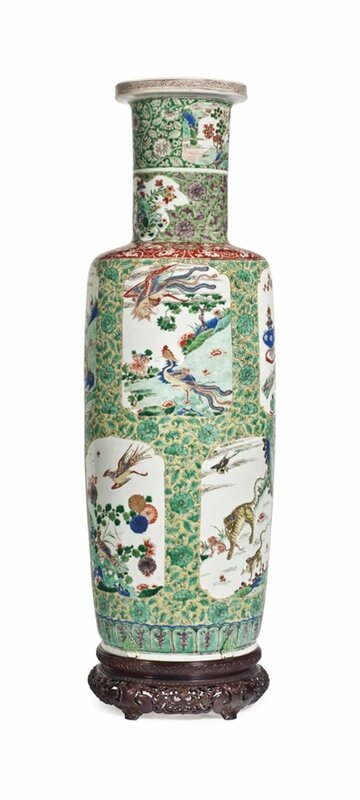A large and finely decorated famille verte rouleau vase, Kangxi period (1662-1722)
Lot 870. A large and finely decorated famille verte rouleau vase, Kangxi period (1662-1722); 28 ¾ in. (73 cm.) high. Estimate USD 60,000 - USD 80,000. Price realised USD 112,500. © Christie's Image Ltd 2016.
The tall body is finely decorated with two registers of shaped panels depicting auspicious animals including a tiger, a phoenix, a lion, ducks and peacocks, and one panel depicting archaistic vessels containing flowers and scholar's objects, all reserved on a yellow ground painted with lotus scroll. The neck is decorated with further scroll on a green ground and is separated into two registers by a bow-string band, wood stand
Provenance: John D. Rockefeller Jr. (1874-1960) Collection.
The Metropolitan Museum of Art, New York, accessioned in 1960.
Note: It was not until 1913 that John D. Rockefeller, Jr., a noted collector of European paintings and textiles, discovered Chinese ceramics, when he was looking for two vases to adorn the mantelpiece of his New York home at 10 West 45th Street. By 1915, when J.P. Morgan died and his porcelain collection was sold by the art dealer Joseph Duveen, Rockefeller’s interest in the field was fully sparked. Duveen offered the Morgan ceramics to Rockefeller, Henry Clay Frick, and Joseph E. Widener. The scale of John D., Jr.’s desired purchase of the Morgan porcelains, however, was great enough to necessitate a loan of some $2 million from his father, John D. Rockefeller, Sr. “I have never squandered money on horses, yachts, automobiles or other foolish extravagances,” the collector wrote in a letter outlining his request. “A fondness for these porcelains is my only hobby – the only thing on which I have cared to spend money. I have found their study a great recreation and diversion, and I have become very fond of them…. The money put into these porcelains is not lost or squandered… I think you do not realize how much I should like to do it, for you do not know the beauty and charm of these works of art…” (R. Fosdick, John D. Rockefeller, Jr., A Portrait, New York, 1956, p. 335) John D., Sr. duly gifted the required funds, and a collection of exceptional beauty and provenance was born. In the decades to come, John D., Jr., would further advance his assemblage of Chinese ceramics through personal scholarship and a commitment to acquiring the very best.
According to his biographer, Rockefeller would spend hours examining and contemplating his objects. To display the pieces to their full potential, he had noted architect Welles Bosworth design stands for them. Many of the stands featured stabilizing clips painted to conform to the design of the porcelain, as seen on the present vase and others in this catalogue.
Christie's. Collected in America: Chinese Ceramics from the Metropolitan Museum of Art, 15 September 2016, New York, Rockefeller Plaza

/https%3A%2F%2Fprofilepics.canalblog.com%2Fprofilepics%2F1%2F0%2F100183.jpg)
/https%3A%2F%2Fstorage.canalblog.com%2F03%2F02%2F119589%2F96711876_o.jpg)
/https%3A%2F%2Fstorage.canalblog.com%2F11%2F31%2F119589%2F94773502_o.jpg)
/https%3A%2F%2Fstorage.canalblog.com%2F20%2F83%2F119589%2F94772815_o.jpg)
/https%3A%2F%2Fstorage.canalblog.com%2F26%2F72%2F119589%2F75604929_o.jpg)
/https%3A%2F%2Fstorage.canalblog.com%2F59%2F60%2F119589%2F26458628_o.jpg)



/image%2F1371349%2F20240312%2Fob_d85a23_7c75148f-146b-47b4-9f64-c9ed71d44866.jpg)
/image%2F1371349%2F20240312%2Fob_a744a4_90a6e8db-4c32-4e63-868b-06b6e85992f3.jpg)
/image%2F1371349%2F20240312%2Fob_756172_431246795-1632197490883597-85408958981.jpg)
/http%3A%2F%2Fstorage.canalblog.com%2F89%2F26%2F119589%2F129685724_o.jpg)